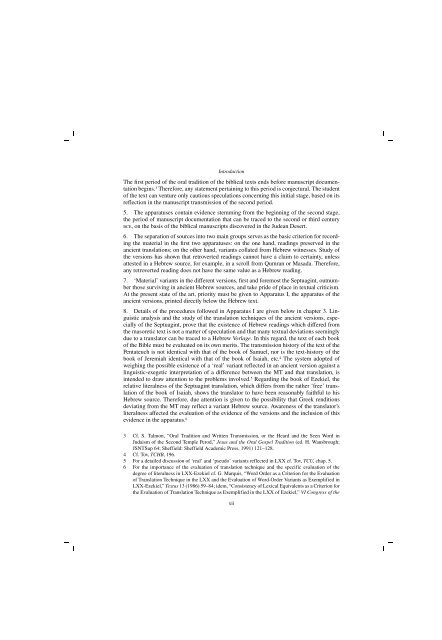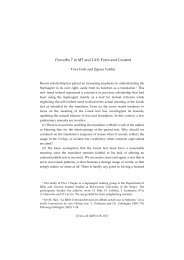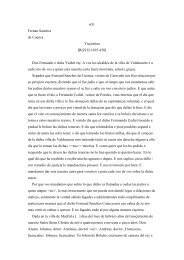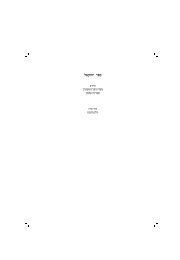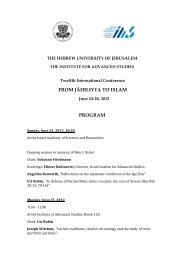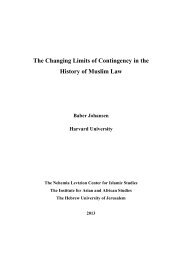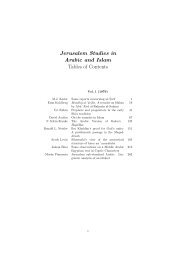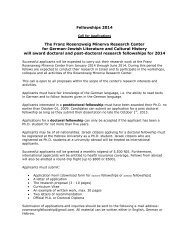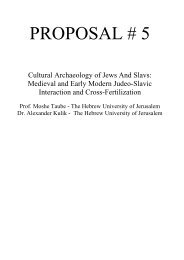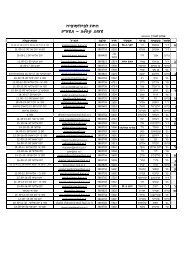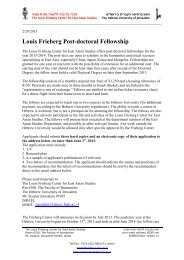THE BOOK OF EZEKIEL Moshe H. Goshen-Gottstein Shemaryahu ...
THE BOOK OF EZEKIEL Moshe H. Goshen-Gottstein Shemaryahu ...
THE BOOK OF EZEKIEL Moshe H. Goshen-Gottstein Shemaryahu ...
You also want an ePaper? Increase the reach of your titles
YUMPU automatically turns print PDFs into web optimized ePapers that Google loves.
Introduction<br />
The first period of the oral tradition of the biblical texts ends before manuscript documentation<br />
begins. 3 Therefore, any statement pertaining to this period is conjectural. The student<br />
of the text can venture only cautious speculations concerning this initial stage, based on its<br />
reflection in the manuscript transmission of the second period.<br />
5. The apparatuses contain evidence stemming from the beginning of the second stage,<br />
the period of manuscript documentation that can be traced to the second or third century<br />
BCE, on the basis of the biblical manuscripts discovered in the Judean Desert.<br />
6. The separation of sources into two main groups serves as the basic criterion for recording<br />
the material in the first two apparatuses: on the one hand, readings preserved in the<br />
ancient translations; on the other hand, variants collated from Hebrew witnesses. Study of<br />
the versions has shown that retroverted readings cannot have a claim to certainty, unless<br />
attested in a Hebrew source, for example, in a scroll from Qumran or Masada. Therefore,<br />
any retroverted reading does not have the same value as a Hebrew reading.<br />
7. ‘Material’ variants in the different versions, first and foremost the Septuagint, outnumber<br />
those surviving in ancient Hebrew sources, and take pride of place in textual criticism.<br />
At the present state of the art, priority must be given to Apparatus I, the apparatus of the<br />
ancient versions, printed directly below the Hebrew text.<br />
8. Details of the procedures followed in Apparatus I are given below in chapter 3. Linguistic<br />
analysis and the study of the translation techniques of the ancient versions, especially<br />
of the Septuagint, prove that the existence of Hebrew readings which differed from<br />
the masoretic text is not a matter of speculation and that many textual deviations seemingly<br />
due to a translator can be traced to a Hebrew Vorlage. In this regard, the text of each book<br />
of the Bible must be evaluated on its own merits. The transmission history of the text of the<br />
Pentateuch is not identical with that of the book of Samuel, nor is the text-history of the<br />
book of Jeremiah identical with that of the book of Isaiah, etc. 4 The system adopted of<br />
weighing the possible existence of a ‘real’ variant reflected in an ancient version against a<br />
linguistic-exegetic interpretation of a difference between the MT and that translation, is<br />
intended to draw attention to the problems involved. 5 Regarding the book of Ezekiel, the<br />
relative literalness of the Septuagint translation, which differs from the rather ‘free’ translation<br />
of the book of Isaiah, shows the translator to have been reasonably faithful to his<br />
Hebrew source. Therefore, due attention is given to the possibility that Greek renditions<br />
deviating from the MT may reflect a variant Hebrew source. Awareness of the translator’s<br />
literalness affected the evaluation of the evidence of the versions and the inclusion of this<br />
evidence in the apparatus. 6<br />
3 Cf. S. Talmon, “Oral Tradition and Written Transmission, or the Heard and the Seen Word in<br />
Judaism of the Second Temple Perod,” Jesus and the Oral Gospel Tradition (ed. H. Wansbrough;<br />
JSNTSup 64; Sheffield: Sheffield Academic Press, 1991) 121–128.<br />
4 Cf. Tov, TCHB, 196.<br />
5 For a detailed discussion of ‘real’ and ‘pseudo’ variants reflected in LXX cf. Tov, TCU, chap. 5.<br />
6 For the importance of the evaluation of translation technique and the specific evaluation of the<br />
degree of literalness in LXX-Ezekiel cf. G. Marquis, “Word Order as a Criterion for the Evaluation<br />
of Translation Technique in the LXX and the Evaluation of Word-Order Variants as Exemplified in<br />
LXX-Ezekiel,” Textus 13 (1986) 59–84; idem, “Consistency of Lexical Equivalents as a Criterion for<br />
the Evaluation of Translation Technique as Exemplified in the LXX of Ezekiel,” VI Congress of the<br />
xii


